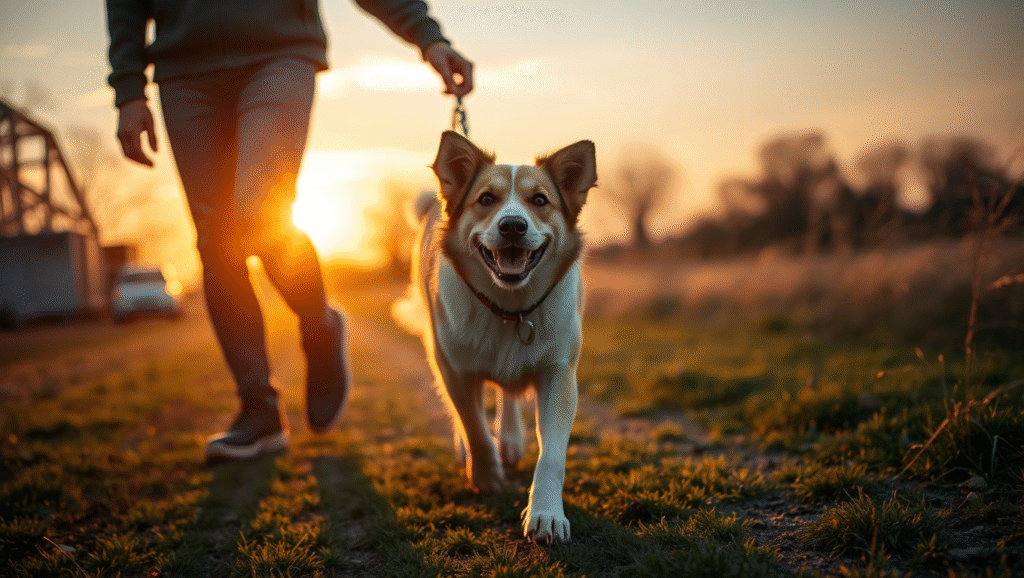When you’re wondering why your dog is crying without pain, it can be confusing and worrisome. Is something bothering them?
Are they scared or anxious?
In this article, we’ll explore the common reasons your furry friend might be vocalizing, as well as signs to look for that indicate emotional distress. Understanding your dog’s behavior can help you support them better, so let’s dive into their world and figure out what’s going on!
Key Insights
- Your dog may cry for attention and love.
- Boredom can make your dog whine and cry.
- Anxiety or stress could be causing the noise.
- Hunger might be the reason for your dog’s cries.
- They might be trying to communicate their needs.

Summary
Understanding Your Dog’s Crying: Why Is My Dog Crying Without Pain?
Have you ever found yourself wondering, Why is my dog crying without pain? It can be alarming when our furry friends start to whimper or whine, especially when we can’t pinpoint a reason. It’s natural to feel concerned. Dogs can’t talk, so their vocalizations are often their way of communicating with us. Understanding why your dog is crying can help you address their needs better and strengthen your bond.
Sometimes, it’s not about physical pain at all. We’ll dive into the various reasons why your dog might be crying, even when they seem perfectly healthy.
Common Reasons for Dog Crying: What You Need to Know
So, let’s get into it. Dogs cry for a variety of reasons, and not all of them are related to pain. Here are some common reasons:
- Hunger or Thirst: Just like us, dogs can get vocal when they’re hungry or thirsty. If it’s been a while since their last meal or they haven’t had a drink, that might be why they’re crying. Have you checked their food and water bowls lately?
- Attention-Seeking: Dogs are social creatures. Sometimes, they just want your attention. If they feel ignored, they might start crying to get you to notice them. Have you ever noticed your dog whining when you’re busy with something else?
- Boredom: Dogs need mental and physical stimulation. If they’re not getting enough exercise or playtime, they might cry out of boredom. Think about it—wouldn’t you get a bit restless if you were cooped up all day? For more ways to keep your dog entertained, consider how to manage their alone time.
- Separation Anxiety: Some dogs get really anxious when left alone. If your dog cries when you leave the house or even when you step out of the room, they might be experiencing separation anxiety. Understanding this can help you provide better support, especially in the context of preparing your home for an adopted dog.
- Fear or Stress: Loud noises, like thunderstorms or fireworks, can scare dogs. If your dog is crying during these events, it could be their way of expressing fear or stress.
Understanding these reasons can help you figure out what your dog is trying to tell you. Keep an eye on their behavior and try to identify any patterns.
Emotional Distress in Dogs: Signs and Symptoms
Dogs, just like humans, can experience emotional distress. It’s important to recognize the signs so you can help your furry friend. Here are some symptoms to watch out for:
- Excessive Barking or Whining: If your dog is crying more than usual, it could be a sign of emotional distress.
- Changes in Appetite: A sudden loss of interest in food or treats can indicate that something isn’t right. For insights on nutrition, check out ways to maximize your dog’s nutrition.
- Withdrawal: If your dog becomes less social, hiding away or avoiding interaction, they might be feeling down.
- Destructive Behavior: Chewing on furniture or digging can be a sign of anxiety or boredom.
- Pacing or Restlessness: If your dog can’t seem to settle down, it could be a sign they’re feeling anxious.
If you notice any of these signs along with crying, it’s worth paying attention. Dogs can’t tell us what’s wrong, so we need to look for these clues.
Changes in Dog Behavior: When to Be Concerned
Sometimes, changes in behavior can be a red flag. If your dog’s crying is accompanied by other unusual behaviors, it’s time to take a closer look. Here are some changes to be concerned about:
- Sudden Changes in Energy Levels: If your usually active dog suddenly becomes lethargic, it might be time to consult a vet.
- Aggression or Irritability: If your dog is snapping or acting out of character, they could be in distress.
- Changes in Bathroom Habits: If your dog starts having accidents indoors or has diarrhea, it could indicate stress or health issues.
- Excessive Grooming: If your dog is licking or chewing at their skin more than usual, it might be a sign of anxiety or discomfort.
If you notice any of these concerning changes, don’t hesitate to reach out to your vet. They can help determine if there’s an underlying issue that needs to be addressed.
Canine Anxiety: How It Affects Your Dog
Anxiety is a common issue for many dogs. It can stem from various sources, like changes in the household, moving to a new place, or even a traumatic event. Here’s how anxiety can affect your dog:
- Physical Symptoms: Dogs with anxiety might show physical signs like trembling, drooling, or panting.
- Behavioral Changes: An anxious dog might bark excessively, chew on furniture, or even try to escape.
- Social Withdrawal: They may avoid social interactions, even with family members they usually love.
- Increased Vocalization: Crying, whining, or barking can become more frequent as they try to express their discomfort.
If you suspect your dog is dealing with anxiety, it’s important to address it early. Ignoring the signs can lead to more serious behavioral issues down the line.
Vocalization in Dogs: What It Means When They Whine
Vocalization is a key way dogs communicate. Whining, in particular, can mean different things depending on the context. Here’s a quick breakdown:
- Excitement: Sometimes, dogs whine when they’re excited, like when you come home or when it’s time for a walk.
- Discomfort: If they’re whining and seem restless, they might be uncomfortable or in need of something.
- Seeking Attention: As mentioned earlier, whining can be a way for dogs to get your attention.
- Fear or Anxiety: If your dog is whining during a stressful situation, like a thunderstorm, it’s likely a sign of fear.
Understanding the context of your dog’s whining can help you respond appropriately. For instance, if they’re whining for attention, you might want to spend some quality time with them.
Stress in Dogs: Identifying Triggers for Crying
Identifying what triggers your dog’s stress can help you manage their crying. Here are some common stressors:
- Loud Noises: Thunder, fireworks, or even loud music can trigger anxiety in dogs.
- Changes in Routine: Dogs thrive on routine. If there’s a sudden change, like a new family member or a change in your schedule, it might stress them out.
- New Environments: Moving to a new home or visiting a new place can be overwhelming for some dogs.
- Social Interactions: Some dogs are more sensitive to interactions with other pets or people. If they feel threatened or uncomfortable, they might cry.
To help your dog, try to keep their environment as stable as possible. If you know certain triggers exist, you can work on desensitizing them or providing a safe space for your dog to retreat to when they feel stressed.
How to Help Your Dog: Tips for Reducing Anxiety and Stress
So, what can you do to help your dog when they’re feeling anxious or stressed? Here are some practical tips:
- Create a Safe Space: Set up a cozy area in your home where your dog can retreat when they’re feeling overwhelmed. It could be a comfy bed or a quiet room.
- Provide Regular Exercise: Physical activity is a great way to reduce anxiety. Make sure your dog gets plenty of walks and playtime.
- Use Calming Products: There are various products available, like calming collars, sprays, and treats that can help soothe anxious dogs.
- Establish a Routine: Dogs thrive on routine. Try to keep feeding, walking, and playtime consistent.
- Practice Positive Reinforcement: Reward your dog for calm behavior. This can help them associate positive experiences with situations that usually stress them out.
- Consider Professional Help: If your dog’s anxiety is severe, a professional dog trainer or a vet can provide guidance on behavior modification techniques or medication if necessary. For more resources, check out guidelines for acting in dog emergencies.
By taking these steps, you can help your dog feel more secure and reduce their crying.
When to Seek Help: Knowing When Your Dog Needs a Vet
Sometimes, despite our best efforts, our dogs may need professional help. Here are some signs that it’s time to consult a vet:
- Persistent Crying: If your dog’s crying doesn’t improve or gets worse, it’s worth seeking advice.
- Physical Symptoms: If they’re showing signs of pain, like limping, or if there are other concerning physical symptoms, don’t wait to see a vet.
- Behavioral Changes: If your dog’s behavior changes drastically or they become aggressive, it’s a sign they might need professional help.
- Loss of Interest: If they stop eating or lose interest in activities they usually enjoy, it’s time to check in with a vet.
Your vet can help determine if there are underlying health issues or if your dog needs a specific treatment plan for anxiety.
Conclusion
In a nutshell, when your dog is crying without pain, it’s often a sign that they’re trying to tell you something important.
Whether it’s hunger, a need for attention, or feelings of anxiety, being attentive to their vocalizations can make all the difference. Remember, dogs are like little furry detectives, communicating their needs through barks and whines.
By understanding their behavior, you can not only help alleviate their distress but also strengthen the bond you share.
So keep your eyes peeled and your heart open. If you ever feel unsure, don’t hesitate to reach out to a vet. After all, your pup relies on you for support and love. For more insights and tips on caring for your furry friends, be sure to check out more articles at Tech Havela.
Happy reading!
Frequently Asked Questions
Why Is My Dog Crying Without Pain?
Your dog might be feeling anxious or scared. Dogs can cry out when they feel lonely or unsure.
What could be causing my dog to cry?
There are many reasons! It could be separation anxiety, boredom, or a need for attention.
Is it normal for dogs to cry?
Yes! Crying is a way dogs communicate. It’s their way to express feelings.
Should I worry if my dog is crying?
Not always. If there are no signs of pain or distress, it’s usually okay. Just check in with them.
Can changes in routine make my dog cry?
Absolutely! Dogs love routines. If something changes, it might make them feel uneasy.
How can I help my dog stop crying?
Try to spend more time with them. Play, cuddle, or even take them for a walk.
When should I call the vet about my dog crying?
If your dog cries a lot or shows signs of distress, it’s a good idea to talk to your vet.
**Sidnir Vieira**
Founder of TechHavela
A passionate pet and tech content creator, helping dog owners across the U.S. make smarter decisions for their furry friends.



